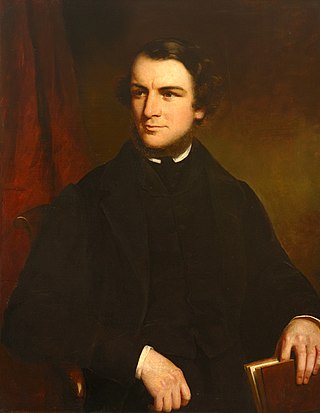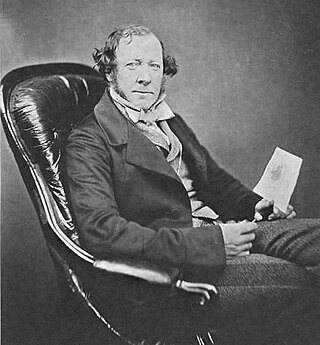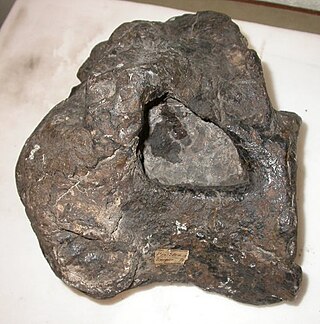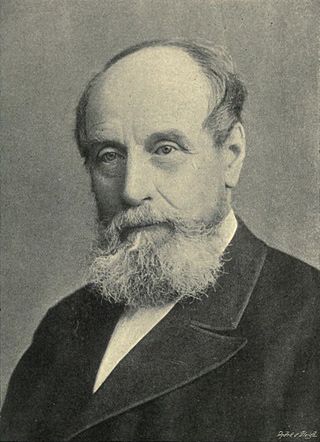
Jean Louis Rodolphe Agassiz FRS (For) FRSE was a Swiss-born American biologist and geologist who is recognized as a scholar of Earth's natural history.

William Buckland DD, FRS was an English theologian who became Dean of Westminster. He was also a geologist and palaeontologist.

Sir William Boyd Dawkins was a British geologist and archaeologist. He was a member of the Geological Survey of Great Britain, Curator of the Manchester Museum and Professor of Geology at Owens College, Manchester. He is noted for his research on fossils and the antiquity of man. He was involved in many projects including a tunnel under the Humber, a Channel Tunnel attempt and the proving of coal under Kent.

John Whitaker Hulke FRCS FRS FGS was a British surgeon, geologist and fossil collector. He was the son of a physician in Deal, who became a Huxleyite despite being deeply religious.

Sir Philip de Malpas Grey Egerton, 10th Baronet FRS was an English palaeontologist and Conservative politician from the Egerton family. He sat in the House of Commons variously between 1830 and his death in 1881.
The Yoredale Series, in geology, is a now obsolete term for a local phase of the Carboniferous rocks of the north of England, ranging in age from the Asbian Substage to the Yeadonian Substage. The term Yoredale Group is nowadays applied to the same broad suite of rocks. The name was introduced by J. Phillips on account of the typical development of the phase in Yoredale, Yorkshire.

Ornithopsis is a genus of sauropod dinosaur, from the Early Cretaceous of England. The type species, which is the only species seen as valid today, is O. hulkei, which is only known from fragmentary remains, and has been regarded by many authors as dubious.

Sir John William Dawson (1820–1899) was a Canadian geologist and university administrator.

Benjamin Franklin Mudge was an American lawyer, geologist and teacher. Briefly the mayor of Lynn, Massachusetts, he later moved to Kansas where he was appointed the first State Geologist. He led the first geological survey of the state in 1864, and published the first book on the geology of Kansas. He lectured extensively, and was department chair at the Kansas State Agricultural College.

Ramsay Heatley Traquair FRSE FRS was a Scottish naturalist and palaeontologist who became a leading expert on fossil fish.

Anthracosaurus is an extinct genus of embolomere, a possible distant relative of reptiles that lived during the Late Carboniferous in what is now Scotland and England. It was a large, aquatic eel-like predator. It has a robust skull about 40 centimetres (1.3 ft) in length with large teeth in the jaws and on the roof of the mouth. Anthracosaurus probably inhabited swamps, rivers and lakes. Its name is Greek for "coal lizard".

Edward Percival (Perceval) Wright FRGSI was an Irish ophthalmic surgeon, botanist and zoologist.

Exocoetoides is an extinct genus of prehistoric ray-finned fish.

Pachyrhizodus is an extinct genus of ray-finned fish that lived during the Cretaceous to Paleocene in what is now Europe, North America, South America, and Oceania. Many species are known, primarily from the Cretaceous of England and the midwestern United States.

Megalichthys is a genus of prehistoric lobe-finned fish which lived during the Devonian and Carboniferous periods. It is the type genus of the family Megalichthyidae. The type species is M. hibberti. The species M. mullisoni, named for fossil preparator C Frederick Mullison, is known from the Catskill Formation of Pennsylvania.
Middridge Quarry is a Site of Special Scientific Interest in the Sedgefield district of County Durham, England. It is a disused quarry, situated alongside the railway line between Newton Aycliffe and Shildon, 1 km south of the village of Middridge.

Ctenacanthus is an extinct genus of ctenacanthiform chondrichthyan. Remains have been found in the Bloyd Formation of Arkansas and the Cleveland Shale of Ohio in the United States and in South America.

Vernonopterus is a genus of eurypterid, a group of extinct aquatic arthropods. Fossils of Vernonopterus have been discovered in deposits of the Carboniferous period in Scotland. The name of the genus derives from the location where the only known fossil has been discovered, Mount Vernon near Airdrie in Lanarkshire, Scotland. A single species of Vernonopterus is recognized, V. minutisculptus, based on fragmentary fossilized tergites, segments on the upper side of the abdomen. The species name minutisculptus refers to the ornamentation of scales that covers the entirety of the preserved parts of the eurypterid.
The geology of the Yorkshire Dales National Park in northern England largely consists of a sequence of sedimentary rocks of Ordovician to Permian age. The core area of the Yorkshire Dales is formed from a layer-cake of limestones, sandstones and mudstones laid down during the Carboniferous period. It is noted for its karst landscape which includes extensive areas of limestone pavement and large numbers of caves including Britain's longest cave network.
Ikamauius is an extinct genus of sawshark from the Cenozoic of New Zealand. It contains a single species, I. ensifer. It is most closely related to the extant Pliotrema, but is distinguished by the presence of barbs on both sides of its rostral denticles.





















